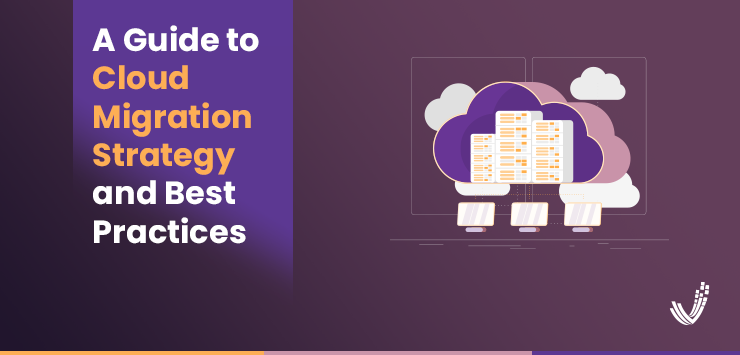Cloud migration is the method of moving data, applications, or other business processes from an on-premise or a third-party environment to a cloud computing environment. A cloud migration strategy is one that explains the end-to-end implementation of the cloud migration process.
It is an essential part of any digital transformation strategy and can help organizations take advantage of the cloud’s scalability, flexibility, and cost savings that it offers. Companies worldwide are now moving their workloads to the cloud or are actively thinking about it.
Cloud migration offers multiple benefits to businesses, and according to a report published in 2019, US-based organizations preferred having a cloud-based IT architecture because of the data protection and security features it comes with.
Moreover, most IT decision-makers prefer cloud architecture not just because of the data security and protection it offers but also because it is cheaper and safer to use compared to traditional methods.
In this blog, we will talk about the steps involved in cloud migration, explore key considerations for developing a successful strategy, and outline best practices for deploying cloud solutions in 2023.
Let’s begin!
What Is a Cloud Migration Strategy?
The first step in any successful cloud migration project is developing a comprehensive strategy. This should include identifying your organization’s goals for migrating to the cloud and outlining how these goals will be achieved.
Additionally, you’ll need to assess what resources are needed to execute the strategy, including personnel and budget. The strategies may also include evaluating existing legacy systems and determining which ones are suitable for migrating and which ones should remain on-premises.
Furthermore, it’s also important to consider security implications when planning your strategy as well as ensuring compliance with relevant laws and regulations.
Why Is It So Important to Have a Cloud Migration Strategy?
Moving business applications to the cloud is becoming increasingly important for companies worldwide. Not only is it cost-effective and less disruptive, but adopting an enterprise cloud migration strategy can help you streamline even your most complicated workloads.
But why do you need to develop a strategy? Because without one, it would be impossible to determine which application workloads are best suited for the cloud and why.
A comprehensive enterprise cloud migration strategy will provide you with the knowledge needed to understand which existing applications should be rewritten, discontinued, left on-premises, or moved as-is to a cloud platform – giving you key insights that no other approach could offer.
Developing a clear strategy for why migrating your applications to the cloud makes sense is essential in delivering high ROI and operational efficiency while ensuring your data remains secure.
Suggested Webinar: Cloud Migration & Modernization with Azure
Process of Cloud Migration: Steps to Follow
Once your strategy has been developed, it’s time to move on to the actual process of migrating your data and applications to the cloud.
Cloud Migration Strategy involves several steps. Let’s have a look at them.
1. Assessing Existing Workloads and Applications
2. Designing Target Architectures
3. Testing Performance
4. Deploying New Services
5. Integrating With Existing Systems
6. Monitoring Operations
7. Optimizing Workloads
8. Provisioning Resources
9. Scaling Up/Down as Needed
10. Developing Strategies for Managing Access Control
11. Automating Processes Where Possible
12. Establishing Backup Strategies for Data Protection
13. Updating Policies Related to Data Storage Security
14. Securing Network Connections Between Multiple Environments
Best Practices for Cloud Migration in 2023
As you embark on your journey towards cloud migration in 2023, there are certain best practices that can help ensure success.
These include:
1. Planning Ahead
Identify what needs to be migrated before beginning any work so that you have a clear roadmap of how everything will fit together once completed. This will ensure that everything goes smoothly.
2. Defining Roles
Establishing who is responsible for each part of the project helps ensure accountability throughout and allows your team members to get exposure by owning the projects and improving their skills.
3. Testing Thoroughly
Thoroughly test all aspects of the system prior to deployment—it enables you to examine the system and understand or predict its performance post-deployment. It can help you save time significantly.
4. Automating Where Possible
Utilize automation wherever possible to reduce manual labor costs associated with migrations, improve the efficiency of your work, and enhance your deliverability, improving the overall outlook.
5. Security Issues
Make sure that all security protocols are deployed before going live. Security is the prime feature of the cloud, but that doesn’t mean that certain protocols can be overlooked—one must take care of security.
6. Monitoring The Progress
Monitor the performance constantly after launch so that potential problems can be quickly identified before they become major issues. Give your technical team the time they need to make things ideal.
7. Scalability Approach
Always plan when it comes to scalability so that future growth can happen without disruption or costly upgrades/additions down the line. Growth can often be a delusion that may be difficult to execute.
Types of Cloud Migration Strategy
When migrating to the cloud, there are multiple options that can be availed.
- Relocating
- Reprovisioning From Scratch
- Re-Platforming
- Refactoring
- Cold Migration
- Retiring
- Retaining
- Live Migration
- Repurchasing
Challenges & Limitations When Migrating to The Cloud
When migrating apps and workloads to the cloud, it is not all fun and games. Cloud migrations can be complex and frustrating. Here are some of the challenges that organizations usually face.
· Strategic Blindness
Organizations looking to find success in the cloud often fail to invest the necessary time and energy into creating a comprehensive migration strategy. While migrating to the cloud may seem straightforward, different applications and datasets can require unique approaches for effective relocations.
It’s important for businesses to evaluate every workload before it’s moved, as this helps ensure that there is a clear benefit for the move. Without an essential business case for each application or dataset, migration can become a costly exercise without realizing tangible rewards.
· Cost Overruns
Migrating to a cloud environment comes with many benefits, but they can also be difficult to manage. Without clear KPIs to track spending and savings after migration, organizations may have difficulty gauging the true cost-benefit of the move.
What’s more, cloud environments are highly dynamic, so costs can vary significantly as new services emerge and the usage of existing applications changes. Organizations looking for successful migrations need to carefully assess their pre- and post-migration spending to understand the economics of making the switch.
· Data Compliance & Security
Cloud migration is a complex task, and data security and compliance are major obstacles that must be navigated. Cloud service providers typically take responsibility for securing their infrastructure, while the customer must ensure data and workloads are properly safeguarded.
It’s important to configure security measures properly, as well as security services and applications with the appropriate controls. Additionally, migrating large amounts of data and configuring access to different environments increases the risk of potential exposure.
Benefits Of Having a Cloud Migration Strategy
- Cloud migrations can offer a tremendous advantage to businesses, saving both cost and time. By migrating applications to the cloud, cloud migration services can automate processes that would traditionally have taken months or even years to complete.
This is possible by creating consistent infrastructure and operations. Cloud migration allows for workloads to be moved in a way that has almost no downtime, allowing businesses to benefit from cloud migration more swiftly than ever before.
Companies interested in cloud migrations should seriously consider the substantial time and cost savings it can offer them.
2. Organizations have much to gain by cloud migration and utilizing cloud providers as part of their overall IT modernization efforts. It eliminates the need for costly technology refresh cycles, allowing business owners to focus on solving problems instead of worrying about upgrades.
Moreover, cloud-native approaches like micro-services and APIs power reliable applications that can run smarter, cheaper, and faster.
Lastly, cloud providers make it easier to deploy modern containerized workloads – making cloud migration economically feasible for any size organization in any sector.
- Cloud migration offers a compelling advantage – instant scalability. By migrating your applications to the cloud, you are enabling your enterprise to meet changing demands at the drop of a hat.
Whether these changes are caused by seasonality, business growth, or an unforeseen spike in interest and activity, cloud providers give you tools with which you can quickly satisfy this demand. Furthermore, cost savings tend to be quite considerable for cloud users since resources are only paid for as and when they’re actually being used.
In short, cloud migration offers enhanced flexibility and substantially reduced costs – all attractive benefits for any enterprise looking to gain a competitive edge in the market.
- Migrating your apps to the cloud can be beneficial if security is your prime consideration. Cloud infrastructure is generally much better and safer as compared to an organization’s on-prem structure, mainly because of the shared responsibility model.
Cloud providers offer a range of services such as security analytics, blocking unwanted traffic, and OS and security updates that are applied automatically – no action is required by user organizations. Also, on the cloud, the data and applications are always available irrespective of the user status, which serves as an additional protection layer for companies.
A cloud migration strategy is beneficial not only in terms of cost savings but also with improved risk assessment capabilities with less time and effort invested.
- Cloud migration has proven to be an advantage to businesses of all sizes, particularly in terms of improved accessibility and a wider ability to access applications and data from any device.
When migrating applications to the cloud, businesses can access vital business-critical information irrespective of location; employees can easily work remotely with the cloud’s help – they no longer need to be bound by their physical office space and enjoy the flexibility cloud provides.
Additionally, since the cloud platform remains secure regardless of machine downtime, companies are now experiencing uninterrupted operations with cloud migration. Businesses must therefore keep these cloud migration advantages in mind if they want to continue running operations efficiently.
Migrating applications to the cloud has numerous benefits, and perhaps one of the most significant is an improved ability of applications to access each other. Cloud-native application methodologies rely on APIs to allow programs to share data regardless of where they are located.
This provides a more standard approach than has been historically had while also giving access to information that might have otherwise been stored in one application alone. Data can now be exchanged across platforms with ease and predictability.
Suggested: Explore Complimentary Cloud Governance Session
Conclusion
Cloud migration is an important part of any digital transformation strategy—it enables organizations to leverage new technologies such as scalability, flexibility, lower costs, etc.—but it must be done right if it is going to be successful.
Taking into account all of the above—strategy development, process implementation, and best practices—will go a long way towards helping ensure a successful transition from an on-premise environment into public clouds by 2023.
With proper planning and guidance from industry experts, businesses can make sure their next journey into the clouds goes off without a hitch!




